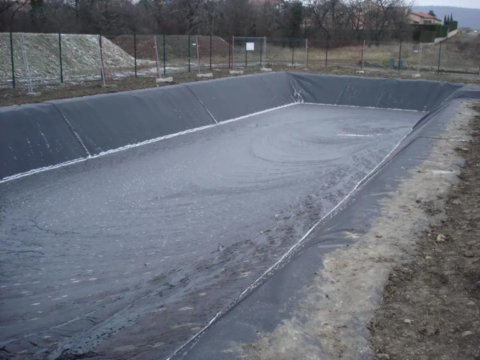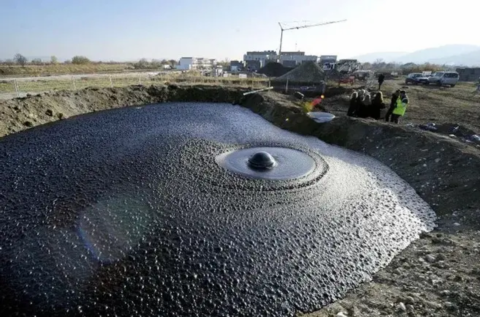The Cébazat oil well, Puy-de-Dôme, France
On October 29, 2012, in Cébazat (France), a small commune on the northern outskirts of Clermont-Ferrand (France), an unexpected event reminded us of the region's geological and industrial heritage. During roadworks to develop the ZAC des Trois Fées (Three Fairies Joint Development Zone), an old, forgotten borehole was accidentally ruptured. This well, drilled in 1981 for geothermal and petroleum research, released a significant leak of hydrocarbons, marking a singular episode in the geological history of the Auvergne.
Right photo : A former oil well rediscovered in the ZAC des Trois-Fées in 2012 (Cébazat, Puy-de-Dôme, France) during earthworks. Fred Marquet - La Montagne
The Limagne plain : a favourable geological setting
The Limagne, a vast sedimentary plain in the Massif Central, is the result of millions of years of marine, lacustrine and fluvial deposits, alternating with volcanic periods. The Oligocene-age marl, rich in organic matter, is the source rock for the region's hydrocarbons. These hydrocarbons naturally rise to the surface through the numerous faults and volcanic vents that cross the plain.
However, the absence of extensive geological reservoirs (or “store rocks”) and effective trap structures limits the accumulation and formation of exploitable deposits. The hydrocarbons found in Limagne are generally heavy, rich in sulfur (up to 7%) and often oxidized, which reduces their quality and profitability.
Why this abandoned well ?
The well in question was drilled in 1981 to a depth of 1,580 metres. The main objective was to explore for geothermal resources and, secondarily, for hydrocarbons. The results were modest: hot water at 85°C was discovered, but with flow rates that were too low; at -830 meters, the borehole traversed sandstone lenses containing small quantities of oil; and at -1020 meters, CO2-rich levels were identified, sometimes under high pressure (up to 4000 m3/hour). These insufficient results led to the abandonment of the well, which was considered sealed and secure at the time.
The accidental uncorking of the well in 2012 released a highly viscous oil, halfway between crude oil and bitumen, at a rate of 3 to 5 m³ per day. Unlike a conventional pressurized gusher, this leak was mainly driven by a “gas lift” mechanism. Bubbles of CO2 from deeper levels pushed the oil through the well casing, and the CO2 bubbles burst in the middle of the spill. (Photograph by Jean-Jacques Arène)
The hydrocarbons that escaped were rich in sulfur, making them costly and economically unattractive to process. Although the leak was moderate, rapid action was required to limit its environmental impact.
Safety and decontamination

The leak quickly spread to the surrounding area, requiring the installation of dikes and retention basins to contain the hydrocarbon.
The operation to make the well safe, coordinated by BRGM and carried out with the collaboration of several players (DGPR, DREAL Auvergne, the oil operator Lundin, and the developer OPHIS), took less than a year and was marked by major technical and environmental challenges. A safety system was installed to control pressures and limit the leak, with successive interventions to stabilize the site.
On January 23, 2013, an initial intervention enabled the installation of a temporary plug to stop the flow of bitumen. Following this, clean-up work was carried out, including emptying the basins and depolluting the site. Between June and September 2013, several phases of intervention were undertaken, starting with an excavation to freeze the upper part of the borehole. Next, civil engineering operations prepared the ground for the arrival of a drilling machine, enabling the borehole to be permanently re-capped with three superimposed cement plugs, totalling 298 metres in length. The evacuated bitumen was burnt in a cement plant in Marseille after desulphurization.
Post-project analyses confirmed the absence of hydrocarbon pollution, a highly satisfactory result for such a complex project, carried out in the heart of a residential area, close to local residents. Although the project received a great deal of media coverage, it did involve a number of nuisances, such as strong odours and round-the-clock work. The operation enabled us to learn important lessons about the management of high pressures (up to 65 bars) and the presence of CO2 in boreholes, underlining the need for full-scale tests to guarantee the safety of interventions of this type.
In addition to the success of the safety operation, it highlighted the importance of monitoring and maintaining abandoned boreholes, as well as the technical preparation required to respond to such unforeseen situations.
Right photo : Bitumen retention basin at the Cébazat site © BRGM
Conclusion
In conclusion, the 2012 Cébazat oil well incident highlights the complexity and risks associated with exploiting geological resources in a region with such a rich industrial heritage as Limagne. Although the event was unexpected, it revealed not only the persistence of hydrocarbons beneath the region's surface, but also the importance of monitoring and managing abandoned wells. Thanks to a coordinated response by several public and private players, the leak was successfully contained in less than a year, limiting the environmental impact. This complex and well-publicized project highlighted the technical challenges involved in managing underground pressure and low-grade hydrocarbons, while underlining the need for thorough testing and preparation for future interventions. The incident also served as a reminder of the importance of continued vigilance, even after industrial sites have been closed, to prevent such incidents in the future and preserve the safety of people and the environment.
References :
Collectif. (2015). La lussatite, l’opale d’Auvergne et autres trésors de la Limagne (Puy-de-Dôme). Hors-série n°21 de la revue Le Règne Minéral. Éditions du Piat, 84 pages
Planet-Terre. (2013). Mise en sécurité réussie d'un forage pétrolier fuyard à Cébazat (Puy-de-Dôme). Planet-Terre, ENS de Lyon.
BRGM. (2015). Mise en sécurité réussie d'un forage pétrolier fuyard à Cébazat (Puy-de-Dôme). BRGM.


